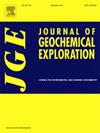Large-scale polymetallic mineralization driven by long-lived magmatic-hydrothermal activity and subducted sediment influx: A case study from Toyoha, NE Japan
IF 3.3
2区 地球科学
Q1 GEOCHEMISTRY & GEOPHYSICS
引用次数: 0
Abstract
Although there is increasing recognition that long-lived magmatic-hydrothermal systems are essential components of large-scale mineralization, relatively little is known about the source processes that enable such activity, especially in areas of average crustal thickness. To address this issue, we investigated the sources of ore-forming elements and drivers of prolonged ore-forming activity (>1 million years) in the Toyoha polymetallic intermediate-sulfidation deposit, located at the northern end of the Northeast Japan Arc. We have presented Pb isotopic evidence that in the southeastern part of the deposit, where the hydrothermal activity lasted substantially longer (>1 million years) than the nearby (<10 km) volcanic activities, sulfide minerals from the ore had a specific metal source in addition to the wall rocks and the magmas observable as nearby extrusive rocks. The additional source was likely latent intrusions similar to the isotopically enriched volcanic rocks ~20 km southeast of the deposit, which incorporated abundant components from the subducting sediment. Based on regional geological, geochemical (major, trace elements and Sr-Nd-Pb isotopes) and geochronological data, we propose that seamount subduction induced the extra sediment input into the mantle wedge, which generated additional magma batches and helped to sustain magmatic-hydrothermal activity in the study area. The large tonnage, particularly of Pb, Zn, Ag, and In, in Toyoha was likely a result of the productive source, which enabled long-lived magmatic-hydrothermal activity, and an effective structure for the transport and trapping of ore-forming materials.

长寿命岩浆-热液活动和俯冲沉积物流入驱动的大规模多金属成矿作用:以日本东北丰河为例
尽管越来越多的人认识到,长期存在的岩浆-热液系统是大规模矿化的必要组成部分,但对于使这种活动成为可能的来源过程,特别是在地壳平均厚度的地区,所知相对较少。为了解决这一问题,我们研究了位于日本东北弧北端的丰河多金属中硫化矿床的成矿元素来源和长期成矿活动的驱动因素(>; 100万年)。我们提出的铅同位素证据表明,在矿床东南部,热液活动持续时间(100万年)比附近(10公里)的火山活动持续时间长得多,矿石中的硫化物矿物除了可以观察到的围岩和岩浆外,还有特定的金属来源。附加物源可能是与矿床东南约20km处同位素富集的火山岩相似的隐伏侵入体,其中含有丰富的俯冲沉积成分。基于区域地质、地球化学(主要元素、微量元素和Sr-Nd-Pb同位素)和年代学数据,我们认为海山俯冲导致额外的沉积物输入地幔楔,从而产生额外的岩浆批,有助于维持研究区岩浆热液活动。丰河地区Pb、Zn、Ag、In的大吨位,特别是Pb、Zn、Ag、In的大吨位,可能是由于丰河的高产源,使得岩浆热液活动持续时间长,形成了有效的成矿物质运输和圈闭构造。
本文章由计算机程序翻译,如有差异,请以英文原文为准。
求助全文
约1分钟内获得全文
求助全文
来源期刊

Journal of Geochemical Exploration
地学-地球化学与地球物理
CiteScore
7.40
自引率
7.70%
发文量
148
审稿时长
8.1 months
期刊介绍:
Journal of Geochemical Exploration is mostly dedicated to publication of original studies in exploration and environmental geochemistry and related topics.
Contributions considered of prevalent interest for the journal include researches based on the application of innovative methods to:
define the genesis and the evolution of mineral deposits including transfer of elements in large-scale mineralized areas.
analyze complex systems at the boundaries between bio-geochemistry, metal transport and mineral accumulation.
evaluate effects of historical mining activities on the surface environment.
trace pollutant sources and define their fate and transport models in the near-surface and surface environments involving solid, fluid and aerial matrices.
assess and quantify natural and technogenic radioactivity in the environment.
determine geochemical anomalies and set baseline reference values using compositional data analysis, multivariate statistics and geo-spatial analysis.
assess the impacts of anthropogenic contamination on ecosystems and human health at local and regional scale to prioritize and classify risks through deterministic and stochastic approaches.
Papers dedicated to the presentation of newly developed methods in analytical geochemistry to be applied in the field or in laboratory are also within the topics of interest for the journal.
 求助内容:
求助内容: 应助结果提醒方式:
应助结果提醒方式:


